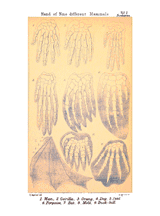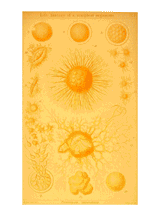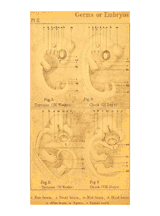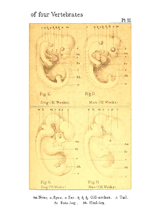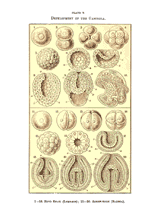


THE
HISTORY OF CREATION:
OR THE DEVELOPMENT
OF THE EARTH AND ITS
INHABITANTS BY THE ACTION OF NATURAL CAUSES.
A POPULAR EXPOSITION OF
THE DOCTRINE OF EVOLUTION IN GENERAL, AND THAT OF
DARWIN, GOETHE, AND LAMARCK IN PARTICULAR.
From the German of
ERNST HAECKEL
Professor in the University of Jena.
The Translation Revised by
Professor E. RAY LANKESTER, M.A., F.R.S.,
Fellow of Exeter College, Oxford.
In Two Volumes
Volume I
New York:
D. APPELTON AND COMPANY
1876
Sixth New English Edition 1914
This electronic edition prepared by Dr.
David C. Bossard
from original documents in his personal library.
January, 2006.
Copyright © 2006 by David C. Bossard.
CONTENTS.
TITLEPAGE i i
PREFACE TO THE NEW ENGLISH EDITION ii ii
iii
iv
AUTHOR'S PREFACE xv xv xvi
xvii
xviii
xix xx
xxi
SUPERSCRIPTION (Wordsworth) xxii xxii
CHAPTER
I.
NATURE AND IMPORTANCE OF THE
DOCTRINE OF FILIATION, OR DESCENT THEORY.
001
002
003
004
005
006
007
008
009
010
011
012
013
014
015 016
017
018
019 020
021
022
023
024
General Importance and Essential
Nature of the Theory of Descent as reformed by Darwin -- Its Special
Importance to Biology (Zoology and Botany). -- Its Special Importance
to the History of the Natural Development of the Human Race.
-- The Theory of Descent a the Non-Miraculous History of
Creation. -- Idea of Creation. -- Knowledge
and Belief. -- History of Creation and History
of Development. -- The Connection between the
History of Individual and Palonto1ogica1 Development. -- The
Theory of Purposelessness, or the Science of Rudimentary Organs
-- Useless and Superfluous Arrangements in Organisms.
-- Contrast between the two entirely opposed Views of
Nature: the Monistic (mechanical, causal) and the Dualistic
(teleological, vital). -- Proof of the former by
the Theory of Descent. -- Unity of Organic and
Inorganic Nature, and the Identity of the Active Causes in both.
-- The Absolute Importance of the Theory of Descent to the
Monistic Conception of all Nature.
CHAPTER
II.
SCIENTIFIC JUSTIFICATION OF THE THEORY OF DESCENT, HISTORY OF
CREATION ACCORDING TO LINNÆUS.
025
026
027 028
029
030
031
032
033
034
035
036
037
038
039
040
041
042
043
044
045
046
047
048
The Theory of Descent, or
Doctrine of Filiation, as the Monistic Explanation of Organic Natural
Phenomena. -- Its Comparison with Newton's
Theory of Gravitation. -- Limits of Scientific Explanation and
of Human Knowledge in general. -- All Knowledge founded
originally on Sensuous Experience, à
posteriori. -- Transition of à posteriori Knowledge,
by Inheritance, into à
priori Knowledge. -- Contrast
between the Supernatural Hypotheses of the Creation according to
Linnæus, Cuvier, Agassiz, and the Natural Theories of Development
according to Lamarck, Goethe, and Darwin. -- Connection
of the former with the Monistic (mechanical), of the latter with the
Dualistic Conception of the Universe. -- Monism
and Materialism. -- Scientific and Moral
Materialism. -- The History of Creation
according to Moses. -- Linnæus as the
Founder of the Systematic Description of Nature and Distinction of
Species. -- Linnæus' Classification and
Binary Nomenclature. -- Meaning of
Liunæus' Idea of Species. -- His History
of Creation. -- Linnæus' View of the
Origin of Species.
CHAPTER
III.
THE HISTORY OF CREATION ACCORDING
TO CUVIER AND AGASSIZ.
049
050
051
052
053
054
055
056
057
058
059
060
061
062
063
064
065
066
067
068 069
070
071
072
073
General Theoretical Meaning of the Idea of Species. -- Distinction
between the Theoretical and Practical Definition of the Idea of Species.
-- Cuvier's Definition of Species. -- Merits
of Cuvier as the Founder of Comparative Anatomy. -- Distinction
of the Four Principal Forms (types or branches) of the Animal Kingdom,
by Cuvier and Bär. -- Cuvier's Services to
Palæontology. -- His Hypothesis of the
Revolutions of our Globe, and the Epochs of Creation separated by them.
-- U
nknown Supernatural Causes of the Revolutions, and the
subsequent New Creations. -- Agassiz's
Teleological System of Nature. -- His Conception
of the Plan of Creation, and its six Categories (groups in
classification). -- Agassiz's Views of the
Creation of Species. -- Rude Conception of the
Creator as a man-like being in Agassiz's Hypothesis of Creation.
-- Its internal Inconsistency and Contradictions with the
important Palæontological Laws discovered by Agassiz.
CHAPTER IV.
THEORY OF DEVELOPMENT
ACCORDING TO GOETHE AND OKEN.
074
075
076
077
078
079
080
081
082 083
084
085
086
087
088
089
090
091
092
093
094 095
096
097
098
099
100
101
Scientific Insufficiency of all
Conceptions of a Creation of Individual Species. -- Necessity
of the Counter-Theories of Development. -- Historical
Survey of the Most Important Theories of Development. -- Greek
Philosophy. -- The Meaning of Natural Philosophy.
-- Goethe. -- His Merits as a
Naturalist. -- His Metamorphosis of Plants.
-- His Vertebral Theory of the Skull. -- His
Discovery of the Mid Jawbone in Man. -- Goethe's
Interest in the Dispute between Cuvier and Geoffroy St. Hilaire.
-- Goethe's Discovery of the Two Organic Formative
Principles, of the Conservative Principle of Specification (by
Inheritance), and of the Progressive Principle of Transformation (by
Adaptation). -- Goethe's Views of the Common
Descent of all Vertebrate Animals, including Man.Theory of Development
according to Gottfried Reinhold Treviranus. -- His
Monistic Conception of Nature. -- Oken.
-- His Natural Philosophy. -- Oken's
Theory of Protoplasm. -- Oken's Theory of
Infusoria (Cell Theory)
CHAPTER
V.
THEORY OF DEVELOPMENT ACCORDING TO KANT
AND LAMARCK.
102
103
104
105
106
107
108
109
110
111
112
113
114
115 116
117
118
119 120
121
122
123
124
125
126
127
Kant's Services to the Theory of
Development. -- His Monistic Cosmology and
Dualistic Biology. -- Contradiction between the
Mechanical and Teleological Conception -- Comparison
of Genealogical Biology with Comparative Philology. -- Views
in favour of the Theory of Descent entertained by Leopold Buch,
Bär, Schleiden, Unger, Schaaffhausen, Victor Carus, Büchner.
-- French Nature-Philosophy. -- Lamarck's
Philosophie Zoologique. -- Lamarck's Monistic
(mechanical) System of Nature. -- His Views of
the Interaction of the Two Organic Formative Tendencies of Inheritance
and Adaptation. -- Lamarck's Conception of Man's
Development from Ape-like Mammals. -- Geoffroy
St. Hilaire's, Naudin's, and Lecoq's Defence of the Theory of Descent.
-- English Nature-Philosophy. -- Views
in favour of the Theory of Descent, entertained by Erasmus Darwin, W.
Herbert, Grant, Freke, Herbert Spencer, Hooker, Huxley. -- The
Double Merit of Charles Darwin.
CHAPTER
VI.
THEORY OF DEVELOPMENT ACCORDING TO
LYELL AND DARWIN.
128
129
130
131
132
133
134
135
136
137
138
139
140
141
142
143
144
145
146
147
148
149
150
151
152
Charles Lyell's Principles of
Geology. -- His Natural History of the Earth's
Development -- Origin of the Greatest Effects
through the Multiplication of the Smallest Causes. -- Unlimited
Extent of Geological Periods. -- Lyell's
Refutation of Cuvier's History of Creation. -- The
Establishment of the Uninterrupted Connection of Historical Development
by Lyell and Darwin. -- Biographical Notice of
Charles Darwin. -- His Scientific Works.
-- His Theory of Coral Reefs. -- Development
of the Theory of Selection. -- A Letter of
Darwin's. -- The Contemporaneous Appearance of
Darwin's and Alfred Wallace's Theory of Selection. -- Darwin's
Study of Domestic Animals and Cultivated Plants. -- Andreas
Wagner's notions as to the Special Creation of Cultivated Organisms for
the Good of Man. -- The Tree of Knowledge in
Paradise. -- Comparison between Wild and
Cultivated Organisms. -- Darwin's Study of
Domestic Pigeons. -- Importance of
Pigeon-breeding. -- Common Descent of all Races
of Pigeons.
CHAPTER VII.
THE THEORY OF SELECTION
(DARWINISM).
153
154
155
156
157
158
159
160
161
162
163
164
165
166
167
168 169
170
171
172
173 174
175
176
177
178
179
Darwinism (Theory of Selection)
and Lamarckism (Theory of Descent). -- The
Process of Artificial Breeding. -- Selection of
the Different Individuals for After-breeding. -- The
Active Causes of Transmutation. -- Change
connected with Food, and Transmission by Inheritance connected with
Propagation. -- Mechanical Nature of these Two
Physiological Functions. -- The Process of
Natural Breeding: Selection in the Struggle for Existence.
-- Malthus' Theory of Population. -- The
Proportion between the Numbers of Potential and Actual Individuals of
every Species of Organisms. -- General Struggle
for Existence, or Competition to attain the Necessaries of Life.
-- Transforming Force of the Struggle for Existence.
-- Comparison of Natural and Artificial Breeding.
-- Selection in the Life of Man. -- Medical
and Clerical Selection.
CHAPTER
VIII.
TRANSMISSION BY INHERITANCE AND
PROPAGATION.
180
181
182 183
184
185
186
187
188
189
190
191
192
193
194 195
196
197
198
199
200
201
202
203
Universality of Inheritance and
Transmission by Inheritance. -- Special
Evidences of the same. -- Human Beings with
four, six, or seven Fingers and Toes. -- Porcupine
Men. -- Transmission of Diseases, especially
Diseases of the Mind. -- Original Sin.
-- Hereditary Monarchies. -- Hereditary
Aristocracy. -- Hereditary Talents and Mental
Qualities. -- Material Causes of Transmission by
Inheritance. -- Connection between Transmission
by Inheritance and Propagation. -- Spontaneous
Generation and Propagation. -- Nonsexual or
Monogonous Propagation. -- Propagation by
Self-division. -- Monera and Amœbæ.
-- Propagation by the formation of Buds, by the forrnation
of Germ-Buds, by the formation of Germ-Cells. -- Sexual
or Amphigonous Propagation. -- Formation of
Hermaphrodites. -- Distinction of Sexes, or
Gonochorism. -- Virginal Breeding, or
Parthenogenesis. -- Material Transmission of
Peculiarities of both Parents to the Child by Sexual Propagation.
CHAPTER IX.
LAWS OF TRANSMISSION BY
INHERITANCE.
204
205
206
207
208
209
210
211
212
213
214
215 216
217
218
219 220
221
222
223
224
225
226
227 228
229
230
231
232
233
234
235
236
237
Theories of Inheritance. -- Difference between
Transmission by Inheritance in Sexual and Nonsexual Propagation.
-- Distinction between Conservative and Progressive
Transmission by Inheritance. -- Laws of
Conservative Transmission: Transmission of Inherited Characters.
-- Uninterrupted or Continuous Transmission. -- Interrupted
or Latent Transmission. -- Alteration
of Generations. -- Relapse. -- Degeneracy.
-- Sexual Transmission. -- Seoondary
Sexual Characters. -- Mixed or Amphigonous
Transmission. -- Hybrids. -- Abridged
or Simplified Transmission. -- Laws of
Progressive Inheritance: Transmission of Acquired Characters.
-- Adapted or Acquired Transmission. -- Fixed
or Established Transmission. -- Homochronous
Transmission (Identity in time). -- Homotopic
Transmission (Identity in place). -- Molecular
Theories of Transmission. -- Pangenesis (Darwin).
-- Perigenesis (Haeckel). -- Idioplasma
(Nägeli). -- Germplasma (Weismann).
-- Intracellular Pangenesis (Vries)
CHAPTER X.
ADAPTATION AND
NUTRITION. LAWS OF ADAPTATION.
238
239
240
241
242
243
244
245
246
247
248
249
250
251
252
253
254
255
256
257
258
259
260
261
262
263
264
265
266
267
268 269
270
271
272
Adaptation and
Variation. -- Connection between Adaptation and
Nutrition (Change of Matter and Growth). -- Distinction
between Indirect and Direct Adaptation. -- Laws
of Indirect or Potential Adaptation. -- Individual
Adaptation. -- Monstrous or Sudden Adaptation.
-- Sexual Adaptation. -- Laws of
Direct or Actual Adaptation. -- Universal
Adaptation. -- Cumulative Adaptation.
-- Cumulative Influence of External Conditions of Existence
and Cumulative Counter-influence of the Organism. -- Free-will.
-- Use and Non-Use of Organs. -- Practice
and Habit. -- Functional Adaptation.
-- Correlative Adaptation. -- Correlation
of Development. -- Correlation of Organs.
-- Explanation of Indirect or Potential Adaptation by the
Correlation of the Sexual Organs and of the other Parts of the Body.
-- Aping or Mimetic Adaptation (Mimicry). -- Divergent
Adaptation. -- Unlimited or Infinite Adaptation
CHAPTER XI.
NATURAL SELECTION BY THE STRUGGLE
FOR EXISTENCE. CELLULAR SELECTION AND PERSONAL SELECTION.
273
274
275
276
277
278
279
280
281
282 283
284
285
286
287
288
289
290
291
292
293
294 295
296
297
298
299
Interaction of the Two Organic
Formative Causes, Inheritance and Adaptation. -- Natural
and Artificial Selection. -- Struggle for
Existence, or Competition for the Necessaries of Life. -- Disproportion
between the Number of Possible or Potential, and the Number of Real or
Actual Individuals. -- Complicated Correlations
of all Neighbouring Organisms. -- Mode of Action
in Natural Selection. -- Homochromic Selection
as the Cause of Sympathetic Colourings. -- Sexual
Selection as the Cause of the Secondary Sexual Characters.
-- The Struggle of Parts in the Organism (Roux).
-- Functional Self-Formation of Suitable Structures.
-- Teleological Mechanism. -- Cellular
Selection (Protista) and Personal Selection (Histonæ).
-- Selection of the Cells and of the Tissues. --
The Principle of Selection in Empedocles. -- Mechanical
Origin of what is Suitable for a Purpose from what is Unsuitable.
-- Philosophical Range of Darwinism.
CHAPTER
XII.
DIVISION OF LABOUR AND DIVERGENCE OF
FORMS. PROGRESS AND RETROGRADATION.
300
301
302
303
304
305
306
307
308
309
310
311
312
313
314
315 316
317
318
319 320
321
322
323
324
325
326
327 328
329
330
331
Division of Labour (Ergonomy) and Divergence of Forms (Polymorphism).
-- Physiologioal Divergence and Morphological
Diferentiation both necessarily determined by Selection. -- Transition
of Varieties into Species. -- The Idea of
Species. -- Hybridism -- Personal
Divergence and Cellular Divergence. -- Differentiation
of the Tissues. -- Primary and
Secondary Tissues. -- Siphonophora.
-- Change of Labour (Metergy). -- Convergence.
-- The Law of Progress and Perfectioning. -- The
Laws of the Development of Mankind. -- The
Relation between Progress and Divergence. -- Centralization
as Progress. -- Retrogradation. -- The
Origin of Rudimentary Organs by Non-Use and Habits discontinued.
-- The Doctrine of Purposelessness, or Dysteleology.
CHAPTER
XIII.
THE INDIVIDUAL DEVELOPMENT OF
ORGANISMS. THE HISTORY OF THE DEVELOPMENT OF THE ANIMAL TRIBES.
332
333
334
335
336
337
338
339
340
341
342
343
344
345
346
347
348
349
350
351
352
353
354
355
356
357
358
359
360
361
362
General Importance of Individual Development (Ontogeny). -- Defeots
of our Present Education. -- Facts in the
Individual Development. -- Agreement in the
Individual Development of Man and the Vertebrate Animals. --
The Human Egg. -- Fertilization.
-- Immortality. -- The Cleavage of
the Egg. -- Formation of Germ-layers.
-- Gastrulation. -- History of the
Development of the Central Nervous System, of the Extremities, of the
Branohial Arches and of the Tail in Vertebrate Animals. -- Causal
Connection between Ontogenesis and Phylogenesis. -- The
Fundamental Law of Biogenesis. -- Palingenesis
or Recapitulative Development. -- Cenogenesis or
Disordered Development. -- Stages in Comparative
Anatomy. -- Its Relation to the
Palæontological and Embryological Series of Development.
CHAPTER
XIV.
MIGRATION AND DISTRIBUTION OF
ORGANISMS. CHOROLOGY AND THE ICE PERIOD OF THE EARTH.
363
364
365
366
367
368 369
370
371
372
373 374
375
376
377
378
379
380
381
382 383
384
385
386
387
388
389
Chorological Facts and Causes. -- Origin of most
Species in one Single Locality: "Centres of Creation." -- Distribution
by Migration. -- Active and Passive Migrations
of Animals and Plants. -- Flying Animals.-
-- Analogies between Birds and Insects. -- Bats.
-- Means of Transport. -- Transport
of Germs by Water and by Wind. -- Continual
Change of the Area of Distribution by Elevations and Depressions of the
Ground. -- Chorological Importance of Geological
Processes. -- Influence of the Change of Climate.
-- Ice or Glacial Period. -- Its
Importance to Chorology. -- Importance of
Migrations for the Origin of New Species. -- Isolation
of Colonists. -- Wagner's Law of Migration.
-- Connection between the Theory of Migration and the
Theory of Seleotion. -- Agreement of its Results
with the Theory of Descent.
CHAPTER
XV.
THEORY OF THE
DEVELOPMENT OF THE UNIVERSE AND OF THE EARTH. SPONTANEOUS GENERATION.
THE CARBON THEORY. THE PLASTID
THEORY.
390
391
392
393
394 395
396
397
398
399
400
401
402
403
404
405
406
407
408
409
410
411
412
413
414
415 416
417
418
419 420
421
422
History of the Development of the Earth. -- Kant's
Theory of the Development of the Universe, or the Cosmological Gas
Theory.Development of Suns, Planets, and Moons. -- First
Origin of Water. Comparison of Organisms and Anorgana. -- Organic
and Inorganic Substances. -- Degrees of Density,
or Conditions of Aggregation. -- Albuminous
Combinations of Carbon. -- Plasson-bodies.
-- Organic and Inorganic Forms. -- Crystals
and Monera. -- Formless Organisms without Organs.
-- Stereometrical Fundamental Forms of Crystals and of
Organisms. -- Organic and Inorganic Forces.
-- Vital Force. -- Growth and
Adaptation in Crystals and in Organisms. -- Formative
Tendencies of Crystals. -- Unity of Organic and
Inorganic Nature.-Spontaneous Generation, or Archigony. -- Autogony
and Plasmogony. -- Origin of Monera by
Spontaneous Genera. tion. -- Origin of Cells
from Monera. -- The Cell Theory. -- The
Plastid Theory. -- Plastids or Structural-Units.
-- C
ytods and Cells. -- F
our
Different Kinds of Plastids.
LIST
OF ILLUSTRATIONS.
PLATES.
Fronticepiece Hand of Nine different Mammals.
I. Life History of a Simplest Organism after 188
II. & III. Germs or Embryos of Four after 334
V. Development of the Gastrula after 344
Note: The fronticepiece is Plate IV.
FIGURES.
Note: High resolution figures are available here.
1. Propagation of Moneron 191
2. Propagation of Amœba 193
3. Egg of Mammal 194
4. First Development of Mammal's Egg 195
5. The Human Egg Enlarged 339
6. Development of Mammal's Egg 343
7. Embryo of a Mammal or Bird 349
High resolution images of all plates and figures are here.



